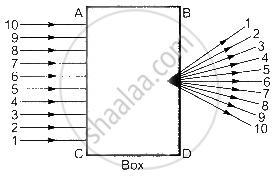Advertisements
Advertisements
Question
An object is placed at a distance equal to 2f in front of a convex lens. Draw a labelled ray diagram to show the formation of image. State two characteristics of the image formed.
Solution
Image formation diagram:

Two characteristics of the image formed:
(1)Nature of image – real and inverted.
(2)Size of Image – same size as that of object.
APPEARS IN
RELATED QUESTIONS
"A convex lens can form a magnified erect as well as magnified inverted image of an object placed in front of it." Draw ray diagram to justify this statement stating the position of the object with respect to the lens in each case.
An object is placed at a distance of 15 cm from a convex lens of focal length 20 cm. List four characteristics (nature, position, etc.) of the image formed by the lens.
When a ray of light enters from one medium to another having different optical densities it bends. Why does this phenomenon occur?
A beam of parallel light rays is incident through the holes on one side of a box and emerges out through the holes on its opposite side as shown in the diagram below:
Which of the following could be inside the box?
(a) a rectangular glass block
(b) a concave lens
(c) a convex lens
(d) a glass prism
What kind of lens can form:
an erect magnified image?
Observe the following figure and complete the table:

| Points | Answer |
| (i) Position of the object | |
| (ii) Position of the image | |
| (iii) Size of the image | |
| (iv) Nature of the image |
State the position of object, position of image, nature of image when: Convex lens is used in observing biological specimens.
Find the odd one out and give its explanation.
A beam of light is incident through the holes on side A and emerges out of the holes on the other face of the box as show in the figure. Which of the following could be inside the box?

Distinguish between:
Concave lens and Convex lens
